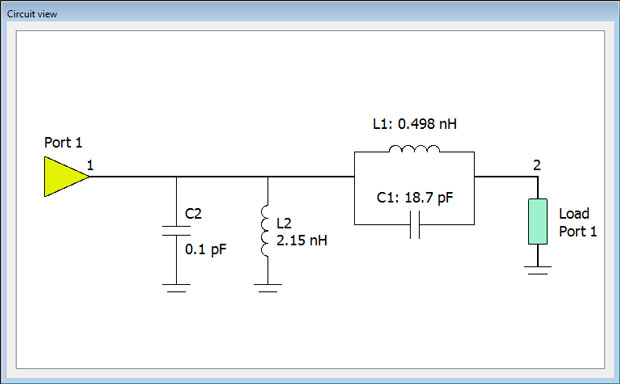Editor’s Pick: Electromagnetic and Circuit Optimization Software Integrate

Remcom says that the Optenni Lab link for its XFdtd 3D electromagnetic simulation software simplifies users’ workflow and generates their matching circuit schematic in one easy step. Shown here is a matching network in Optenni Lab. Image courtesy of Remcom.
Design Exploration and Optimization News
Design Exploration and Optimization Resources


Latest News
October 7, 2015
 Dear Desktop Engineering Reader:
Dear Desktop Engineering Reader:
 The traditional workflow for designers and engineers matching a network topology and initial component values for devices like mobile phones, implantable devices and waveguide antennas is more of a plod than flow. With today's Pick of the Week, you'll see that your workflow can be a lot more energetic.
The traditional workflow for designers and engineers matching a network topology and initial component values for devices like mobile phones, implantable devices and waveguide antennas is more of a plod than flow. With today's Pick of the Week, you'll see that your workflow can be a lot more energetic.
Remcom recently announced the integration of its XFdtd 3D electromagnetic simulation (EM) software and Optenni Lab matching circuit optimization software from Optenni Ltd. What the XFdtd-Optenni Lab integration means for you is that it simplifies your antenna matching circuit optimization workflows by enabling you to generate matching circuit schematics in one step, which means you can get on with the job of full-wave optimizations quickly.
The key here is that the integration brings together XFdtd’s Circuit Element Optimizer add-on module with Optenni Lab. Optenni Lab provides automatic matching circuit generation and optimization routines. The Circuit Element Optimizer determines lumped element values based on radiation efficiency, system efficiency and S-parameters (scattering parameters). Using XFdtd's full-wave FDTD (finite difference time domain) simulation approach, the Circuit Element Optimizer selects the optimal component values for a given matching network layout, printed circuit board, antenna, filters and other RF (radio frequency) structures.
With the integration, you send XFdtd simulation data to Optenni Lab directly. It's a simple drop-down menu procedure to invoke Optenni Lab. Optenni Lab optimizes matching network topologies and component values based on the S-Parameter and efficiency results from your XFdtd simulation. It then returns a choice of optimized matching circuit topologies that meet your design criteria. The XFdtd Circuit Element Optimizer then takes the antenna matching schematic into the electromagnetic simulation and optimizes the lumped circuit elements directly in the physical matching circuit layout.
 Remcom says that the Optenni Lab link for its XFdtd 3D electromagnetic simulation software simplifies users’ workflow and generates their matching circuit schematic in one easy step. Shown here is a matching network in Optenni Lab. Image courtesy of Remcom.
Remcom says that the Optenni Lab link for its XFdtd 3D electromagnetic simulation software simplifies users’ workflow and generates their matching circuit schematic in one easy step. Shown here is a matching network in Optenni Lab. Image courtesy of Remcom.You can learn more about the XFdtd integration with Optenni Lab from today's Pick of the Week write-up. After the main write-up, look for the video link. This brief video shows how the integration changes your workflow and demonstrates how simple the entire matching process can be. Good stuff.
Thanks, Pal. – Lockwood
Anthony J. Lockwood
Editor at Large, Desktop Engineering
Subscribe to our FREE magazine, FREE email newsletters or both!
Latest News
About the Author
Anthony J. Lockwood is Digital Engineering’s founding editor. He is now retired. Contact him via [email protected].
Follow DE



